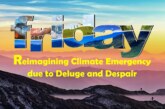
Dr. Arvind Kumar*

The 28th edition of the Conference of the Parties (COP 28) to the United Nations Framework Convention on Climate Change (UNFCCC) unfolded in the dynamic city of Dubai, UAE, spanning from November 30 to December 12, 2023. Notably, this COP marked a historic milestone as the first instance where a member of the Organization of the Petroleum Exporting Countries (OPEC) played host to the global climate forum. Guiding the proceedings was Sultan Ahmed Al Jaber, a figure of strategic significance serving as both the CEO of an influential oil company and the UAE’s Minister of Industry and Advanced Technology. Against the backdrop of COP 27’s advancements in Egypt, where nations unveiled their updated nationally determined contributions (NDCs) to combat greenhouse gas emissions in alignment with the Paris Agreement, COP 28 aimed to further amplify these achievements.
This conference also etched its significance by successfully concluding the inaugural global stocktake (GST), a comprehensive evaluation of collective progress and identification of gaps in global climate action. Moreover, COP 28 became the launching pad for the second cycle of NDCs, delineating the roadmap for climate commitments spanning the years 2024 to 2030. The event served as a pivotal juncture where global leaders convened to steer the course toward a sustainable and resilient future.
The 28th iteration of COP saw itself as a crucial crossroads for the global community, a stage where nations aimed to exhibit their unwavering commitment to combat the pressing climate crisis. Against the backdrop of the far-reaching impacts of the COVID-19 pandemic, which ravaged health, economies, and the environment, this conference stood as a beacon of resilience and determination.However, as world leaders convened, the geopolitical landscape simmered with tensions and conflicts, from the Ukraine war to the Israel-Hamas clash, casting shadows on the prospects of cohesive global collaboration. Amidst these challenges, COP 28 grappled with the task of fostering unity in the face of discord.This article seeks to present an initial appraisal, dissecting the pivotal accomplishments and inherent limitations of the COP 28 discussions. By delving into the ramifications of these outcomes, it endeavors to outline the implications and chart a course for the future of climate action
Landmark agreements and decisions

COP 28 emerged as a catalyst for positive shifts, showcasing an amplified acknowledgment of the climate emergency and the proactive stance taken by diverse stakeholders to address it. Notable milestones from the conference include:
The landmark adoption of the Dubai Declaration stood as a testament to the resolute commitment of participating nations to the UNFCCC and the Paris Agreement. This pivotal document not only reaffirmed this dedication but also lent support to the groundbreaking Global Stocktake (GST) report. Embracing its findings, the declaration served as a blueprint, fostering ambition and action in the upcoming phase of nationally determined contributions (NDCs). Crucially, it recognized the pivotal roles of non-state entities—subnational governments, businesses, civil society, and the youth—and emphasized the need for their robust engagement through inclusive processes.
Several nations, including significant emitters like China, India, Brazil, and Russia, unveiled revised and enhanced NDCs, collectively accounting for more than 40% of global emissions. Their commitments outlined aspirations to reach emissions peak by 2030 and strive for net-zero emissions by 2060 or 2070, aligning with their distinct national circumstances and capabilities. While applauded for their strides, these commitments faced scrutiny for falling short in adequately curbing global warming within the prescribed limits of 1.5°C or 2°C above pre-industrial levels, a verdict echoed by the GST report’s assessments.
During COP 28, a concerted push unfolded to galvanize financial resources, channeling support toward climate endeavors, with a laser focus on bolstering developing nations and safeguarding vulnerable communities. This symphony of initiatives and alliances unveiled during the conference aimed to inject capital, technology, and skill-building prowess into the realms of mitigation, adaptation, and confronting loss and damage. Among these, a standout initiative emerged in the form of the Abu Dhabi Climate Initiative, a bold $10 billion commitment by the UAE spanning the next decade. This ambitious endeavor pledged to fuel clean energy projects and spur innovation in developing nations, setting a high bar for climate-oriented investment.
Moreover, the G7 nations reasserted their dedication to funneling $100 billion annually by 2025 toward buttressing climate action in developing nations, supplementing this commitment with a fresh mechanism designed to rigorously monitor and transparently report their contributions.
Diving deeper into the conference’s thematic undercurrents, COP 28 exalted themes of adaptation, loss and damage, gender, and health, elevating their status to pivotal priorities on the global climate agenda. The conference unveiled a tapestry of decisions and frameworks aimed at amplifying action and support in these domains. From the Adaptation Communication Guidelines to the Santiago Network on Loss and Damage, the Enhanced Lima Work Programme on Gender, and culminating in the Dubai Action Plan on Health and Climate Change, these outcomes underscored a holistic understanding of climate change’s multifaceted impacts. They resonated with a resounding call for comprehensive, integrated approaches to tackle these interwoven challenges head-on.
Whitewashing at COP28
COP 28 grappled with a tapestry of hurdles and inadequacies that dented its effectiveness and cast shadows upon its credibility, laying bare the chasms and discord among the diverse array of participating nations and stakeholders. Here are some key pitfalls that marked the trajectory of COP 28:
Foremost among these challenges was the cloud of ambiguity surrounding the fate of fossil fuels, the primary architects of greenhouse gas emissions and linchpins of economic vitality for several nations, particularly those tethered to oil production. COP 28 floundered in rallying behind a unified stance on the urgency of phasing out these fuels, notably coal, known for its ruinous environmental toll and adverse impacts on public health. More strikingly, the conference sidestepped the contentious issue of fossil fuel subsidies, an annual $300 billion weight on the global economy, skewing market dynamics and handicapping the ascendancy of renewable energy sources.

Compounding these dilemmas was a visible dearth of ambition and concerted action to bridge the emissions chasm and realize the temperature thresholds delineated in the Paris Agreement—a verdict underscored by the sobering revelations of the GST report. Even with the enhanced Nationally Determined Contributions (NDCs) announced at COP 28, the report foretold a grim reality: a trajectory toward a 2.7°C global warming by 2100, a cataclysmic trajectory spelling dire ramifications for both the planet and humanity.
The report’s urgent call to hike the global emissions reduction target from 45% to a more formidable 55% by 2030, relative to 2010 levels, echoed through the corridors of COP 28. However, the conference faltered in securing consensus on a definitive target or timeline for the second NDC cycle, leaving this critical juncture at the discretion of individual countries—a void that potentially complicates concerted global efforts toward climate redemption.
Within the sprawling tapestry of COP 28, a stark imbalance cast its shadow, unveiling an intricate web of disparities and injustices in the realms of action and support—both between mitigation and adaptation, and among developed and developing nations. The symphony of the global climate agenda, as echoed in the halls of the conference, resounded with a discernible tilt toward the primacy of mitigation, notably championed by the developed nations. Yet, this orchestration of priorities inadvertently marginalized and underscored the inadequacy of funds allocated and representation accorded to the critical sphere of adaptation, especially in the domains of developing nations.
As the curtain lifted on the proceedings, COP 28 laid bare a hesitancy and languor among developed nations in discharging their duties, lingering in their strides to fulfill commitments for providing robust financial, technological, and capacity-building support. The brunt of this reluctance fell disproportionately on the least developed countries and small island developing states, standing as the frontline casualties of climate change’s relentless onslaught.
Amidst the corridors of decision-making, a palpable undercurrent of dissatisfaction and frustration reverberated from the voices of civil society and the youth, drowned out by the seemingly deaf ears of negotiators. A crescendo of protests and demonstrations, spearheaded by groups like Fridays for Future, Extinction Rebellion, and Climate Justice Now, punctuated the conference. Their collective plea was a clarion call for immediate and transformative action to confront the climate emergency with the urgency it demands.

Yet, within this grand theater, the conference found itself ensnared in the critique of opacity and perceived influence from the fossil fuel industry and other corporate interests. This specter of controversy sowed seeds of doubt regarding the transparency and accountability of COP 28, with questions looming over the extent of external forces shaping the narrative within its hallowed halls.
The Way Ahead
COP 28 unfolded as a nuanced tapestry of triumphs and tribulations, a reflection of the intricate and multifaceted landscape of the climate challenge. Within its confines, opportunities and obstacles for climate action wove together, illustrating a journey that encompasses both strides forward and the hurdles that lie ahead. The conference served as a mirror to the global community, revealing that, while progress has been etched into the narrative and certain victories attained, the path toward satisfaction remains an extensive traverse.Beyond the technical and scientific facets, COP 28 underscored the political and ethical dimensions integral to grappling with the climate challenge. It resonated with a call for heightened cooperation, solidarity, responsibility, and accountability—mandates that echo across the spectrum of participants and stakeholders.
To surmount the gaping emissions void and meet the temperature benchmarks outlined in the Paris Agreement, a clarion call for elevated ambition and tangible actions rang through the conference halls. A pivotal strategy involves crafting and implementing more audacious and pragmatic Nationally Determined Contributions (NDCs) during the impending second cycle. Simultaneously, an expeditious transition toward a low-carbon, resilient economy and society, anchored in renewable energy sources and sustainable consumption and production, became the clarion call of the hour.
Striking a balance between mitigation and adaptation endeavors and ensuring equity and justice across developed and developing nations became a central tenet of COP 28’s narrative. This blueprint involves bolstering financial, technological, and capacity-building support for developing countries—particularly those most vulnerable to the ravages of climate change—and amplifying their role in decision-making and implementation processes.At the heart of this narrative is a compelling call to engage and empower non-state actors—subnational governments, businesses, civil society, and youth. Recognized as pivotal agents of change, these actors wield the potential to offer innovative and effective solutions to combat the climate crisis. Establishing inclusive and participatory platforms and mechanisms to integrate them into the global climate agenda emerged as an imperative, acknowledging their indispensable role in steering the course toward a sustainable and resilient future.
Uprooting the very foundations of the climate crisis demands a frontal assault on its bedrock: poverty, inequality, discrimination, and conflict. These ills, both the offspring and the adversaries of climate change, beckon for a nuanced, all-encompassing strategy—a strategy that interweaves the social, economic, and environmental tapestries of climate action.COP 28, far from a curtain call, heralds the inauguration of a fresh epoch in the realm of climate action. It stands as a clarion call, summoning forth increased resolve, unwavering dedication, and a symphony of collaboration, coordination, innovation, and inspiration from all players in this grand stage play.
This collective endeavor stands as the cornerstone upon which our shared aspirations rest—a future safeguarding the planet’s vitality and nurturing the resilience of humanity. Only by uniting in these concerted efforts can we chart the trajectory toward a secure and sustainable tomorrow, where the harmonious coexistence of our planet and its inhabitants is not just a vision but a palpable reality.
*Editor, Focus Global Reporter



